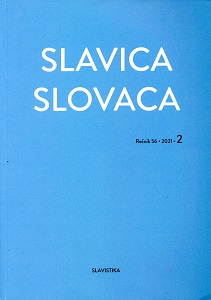Nomination of extramarital relations in the language of traditional folk culture (based on the material of Slavic languages and cultures in comparison with English)
Nomination of extramarital relations in the language of traditional folk culture (based on the material of Slavic languages and cultures in comparison with English)
Author(s): Oleh Tyshchenko, Olga Iermachkova, Mariia MalaniukSubject(s): Applied Linguistics, Sociolinguistics
Published by: SAV - Slovenská akadémia vied - Slovenský komitét slavistov a Slavistický ústav Jána Stanislava SAV, v.v.i.
Keywords: Anti-concept; frame modeling; illegitimate child; wedlock, structural and semantic models; dialect phraseology; superstitions;
Summary/Abstract: Verbalization of the idea of family and matrimonial relations in different languages as well as the representation of underlying language and conceptual pictures of the world, cognitive, ethical and axiological senses and conceptions are directly related to the notion of anti-norm (adultery, breaking of marriage oaths, concubinage, etc.) and, in particular, to the conceptualization of the special status of children born within these relations (the illegitimate child). The latter are very often explicitly negatively marked and connoted or nominated by means of euphemisms. This article represents the frame-modeling of the concept of the “illegitimate child”, and highlights the ways of its nomination in imagery and the main directions of linguistic conceptualization of anti-marriage in the Russian, Ukrainian, Belarusian, Polish, Czech and Slovak languages compared to English. It focuses on semantic phraseological filling of the corresponding subframes (phrases, stable word combinations, euphemisms, proverbs endowed with cultural symbolism, in particular stereotypes, beliefs, prohibitions and other folk conceptions). It reveals the existing semantic profiles and cultural codes that partici¬pate in the nomination of these ethnic cultural senses (existential, floral, landscape, spatial-locative, etc.). The description of Slavonic, in particular, Russian, Ukrainian, Polish, Czech and Slovak material requires applying the methodology of structural semantic modeling of phraseological units developed in Slavonic ethno-phraseology. We treat the anti-concept absence of marriage as opposite to the sphere of marriage (legal matrimonial relations) that encloses: The subframe of the birth of an illegitimate child in the unity of actional, objective and verbal codes in the cultural text and in dialectal phrase¬ology; The complex of ethno-cultural conceptions connected to the natural marriage (linguistic and cultural image of the so called “living on faith”, concubinage, especially the explication of the related symbolic function of things and realia.
Journal: Slavica Slovaca
- Issue Year: 56/2021
- Issue No: 02
- Page Range: 205-225
- Page Count: 21
- Language: English

